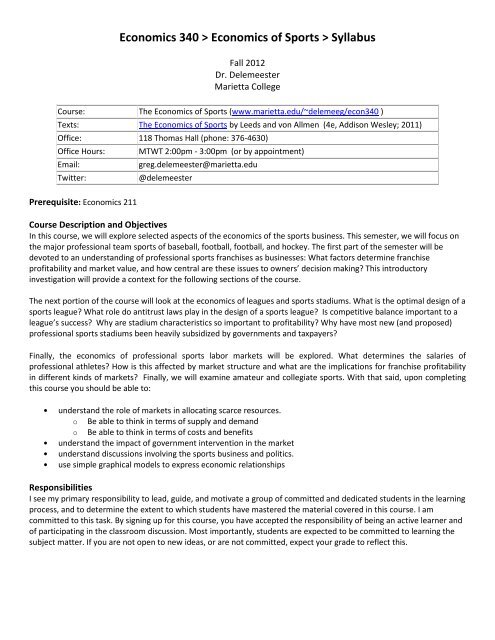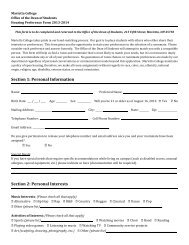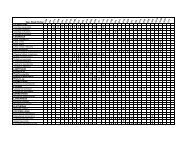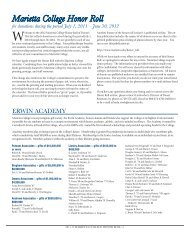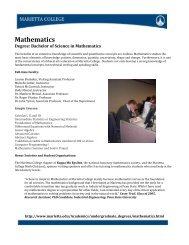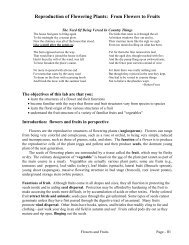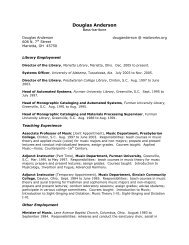Economics 340 > Economics of Sports > Syllabus - Marietta College
Economics 340 > Economics of Sports > Syllabus - Marietta College
Economics 340 > Economics of Sports > Syllabus - Marietta College
Create successful ePaper yourself
Turn your PDF publications into a flip-book with our unique Google optimized e-Paper software.
<strong>Economics</strong> <strong>340</strong> > <strong>Economics</strong> <strong>of</strong> <strong>Sports</strong> > <strong>Syllabus</strong><br />
Fall 2012<br />
Dr. Delemeester<br />
<strong>Marietta</strong> <strong>College</strong><br />
Course: The <strong>Economics</strong> <strong>of</strong> <strong>Sports</strong> (www.marietta.edu/~delemeeg/econ<strong>340</strong> )<br />
Texts: The <strong>Economics</strong> <strong>of</strong> <strong>Sports</strong> by Leeds and von Allmen (4e, Addison Wesley; 2011)<br />
Office: 118 Thomas Hall (phone: 376-4630)<br />
Office Hours: MTWT 2:00pm - 3:00pm (or by appointment)<br />
Email: greg.delemeester@marietta.edu<br />
Twitter: @delemeester<br />
Prerequisite: <strong>Economics</strong> 211<br />
Course Description and Objectives<br />
In this course, we will explore selected aspects <strong>of</strong> the economics <strong>of</strong> the sports business. This semester, we will focus on<br />
the major pr<strong>of</strong>essional team sports <strong>of</strong> baseball, football, football, and hockey. The first part <strong>of</strong> the semester will be<br />
devoted to an understanding <strong>of</strong> pr<strong>of</strong>essional sports franchises as businesses: What factors determine franchise<br />
pr<strong>of</strong>itability and market value, and how central are these issues to owners’ decision making? This introductory<br />
investigation will provide a context for the following sections <strong>of</strong> the course.<br />
The next portion <strong>of</strong> the course will look at the economics <strong>of</strong> leagues and sports stadiums. What is the optimal design <strong>of</strong> a<br />
sports league? What role do antitrust laws play in the design <strong>of</strong> a sports league? Is competitive balance important to a<br />
league’s success? Why are stadium characteristics so important to pr<strong>of</strong>itability? Why have most new (and proposed)<br />
pr<strong>of</strong>essional sports stadiums been heavily subsidized by governments and taxpayers?<br />
Finally, the economics <strong>of</strong> pr<strong>of</strong>essional sports labor markets will be explored. What determines the salaries <strong>of</strong><br />
pr<strong>of</strong>essional athletes? How is this affected by market structure and what are the implications for franchise pr<strong>of</strong>itability<br />
in different kinds <strong>of</strong> markets? Finally, we will examine amateur and collegiate sports. With that said, upon completing<br />
this course you should be able to:<br />
• understand the role <strong>of</strong> markets in allocating scarce resources.<br />
o Be able to think in terms <strong>of</strong> supply and demand<br />
o Be able to think in terms <strong>of</strong> costs and benefits<br />
• understand the impact <strong>of</strong> government intervention in the market<br />
• understand discussions involving the sports business and politics.<br />
• use simple graphical models to express economic relationships<br />
Responsibilities<br />
I see my primary responsibility to lead, guide, and motivate a group <strong>of</strong> committed and dedicated students in the learning<br />
process, and to determine the extent to which students have mastered the material covered in this course. I am<br />
committed to this task. By signing up for this course, you have accepted the responsibility <strong>of</strong> being an active learner and<br />
<strong>of</strong> participating in the classroom discussion. Most importantly, students are expected to be committed to learning the<br />
subject matter. If you are not open to new ideas, or are not committed, expect your grade to reflect this.
Course Requirements and Policies<br />
1. There will be three exams given. Exams may consist <strong>of</strong> essay, analytical, multiple choice, and/or true-false-explain<br />
questions. Make-up exams will not be given.<br />
2. There will be three problem sets distributed. These will form the basis <strong>of</strong> in-class assignments and homework.<br />
Make-up assignments will not be given. Several exam questions may come directly from the problem sets.<br />
3. Fantasy League franchise management. You are required to manage a fantasy league NFL football team and<br />
prepare an analysis paper based upon your experience. See details below.<br />
4. Class Attendance and Participation. As a rational adult, you have the ability to weigh the benefits and costs <strong>of</strong><br />
attending class. However, as an adult, you should view attendance as part <strong>of</strong> your job. An active learning approach is<br />
essential to doing well in this course. Consequently, you should expect to actively ask and answer questions during<br />
class. Moreover, your participation is likely to create a positive externality for your fellow students.<br />
5. Academic dishonesty is a breach <strong>of</strong> the trust that the instructor and your fellow classmates place in you and will not<br />
be tolerated. Academic dishonesty includes cheating, plagiarism, theft, or improper manipulation <strong>of</strong> laboratory or<br />
research data or theft <strong>of</strong> services. A substantiated case <strong>of</strong> academic dishonesty may result in disciplinary action,<br />
including a failing grade on the project, a failing grade in the course, or expulsion from the <strong>College</strong>" ( <strong>Marietta</strong><br />
<strong>College</strong> Undergraduate Programs, 2012-2013 Catalog, p. 130). All suspected cases will follow the procedures<br />
outlined in the <strong>Marietta</strong> <strong>College</strong> Catalog. Copyright violations are also quite serious breaches <strong>of</strong> the law. Please<br />
visit the MC copyright tips page (http://library.marietta.edu/services/faculty/copyright_tips.html) for further details.<br />
6. Any student needing accommodations due to a documented disability should notify the instructor AND the<br />
Academic Resource Center (Andrews Hall, Third Floor, 376-4700) at the beginning <strong>of</strong> the semester for further<br />
instructions.<br />
7. Co-curricular probation for those on academic probation is in effect. Please refer to the college catalog for details<br />
(<strong>Marietta</strong> <strong>College</strong> Undergraduate Programs, 2012-2013 Catalog, p. 136).<br />
8. Your grade will be determined as follows:<br />
Grades are allocated as follows:<br />
Exams (average <strong>of</strong> 3) 65%<br />
Homework<br />
(average <strong>of</strong> your top 10 scores) 20%<br />
Franchise Management 15%<br />
Grades will be assigned according to the following plus/minus system, using standard<br />
rounding methods:<br />
Grade A+ A A- B+ B B- C+ C C- D+ D D- F<br />
Percent<br />
Score<br />
97<br />
+<br />
93-<br />
96<br />
90-<br />
92<br />
87-<br />
89<br />
83-<br />
86<br />
80-<br />
82<br />
77-<br />
79<br />
73-<br />
76<br />
70-<br />
72<br />
67-<br />
69<br />
63-<br />
66<br />
60-<br />
62<br />
59<br />
-
League Schedule*<br />
Course Outline<br />
Chapter Topic<br />
Part I<br />
Leeds/von Allmen 1 Introduction<br />
Leeds/von Allmen 2 Review <strong>of</strong> the Economist's Arsenal<br />
Leeds/von Allmen 3 <strong>Sports</strong> Franchises as Pr<strong>of</strong>it-Max Firms<br />
Determine Franchise Owners and Assign Markets and S<strong>of</strong>tware Review: August 28<br />
League Constitution: August 30<br />
Business Plan Due: September 4<br />
Free Agent Auction: September 4<br />
Exam 1: September 25, 2012<br />
Part II<br />
Leeds/von Allmen 4 Monopoly and Antitrust<br />
Leeds/von Allmen 5 Competitive Balance<br />
Leeds/von Allmen 6 Public Finance <strong>of</strong> <strong>Sports</strong><br />
Leeds/von Allmen 7 Costs and Benefits <strong>of</strong> a Franchise to a City<br />
Part III<br />
Leeds/von Allmen 8 Labor Markets in Pr<strong>of</strong>essional <strong>Sports</strong><br />
Leeds/von Allmen 9 Labor Market Imperfections<br />
Leeds/von Allmen 10 Discrimination<br />
Leeds/von Allmen 11 Amateur and <strong>College</strong> <strong>Sports</strong><br />
Fantasy League Analysis Paper Due: December 6<br />
Exam 2: November 1, 2012<br />
Exam 3: December 11, 2012 (Noon)<br />
First Game <strong>of</strong> the Week<br />
Fantasy League Week #1 September 5<br />
Fantasy League Week #2 September 13<br />
Fantasy League Week #3 September 20<br />
Fantasy League Week #4 September 27<br />
Fantasy League Week #5 October 4<br />
Fantasy League Week #6 October 11<br />
Fantasy League Week #7 October 18<br />
Fantasy League Week #8 October 25<br />
Fantasy League Week #9 November 1<br />
Fantasy League Week #10 November 8<br />
Play<strong>of</strong>f Week #1 November 15<br />
Play<strong>of</strong>f Week #2 November 22<br />
Play<strong>of</strong>f Week #3 November 29<br />
*All starting rosters must be submitted by kick<strong>of</strong>f prior to the first game <strong>of</strong> the week.
1. Getting Started<br />
Guide to EconFantasy<br />
EconFantasy.com is a 12 team Fantasy <strong>Sports</strong> League. Student teams will have the opportunity to make league and front <strong>of</strong>fice<br />
financial decisions while also participating in head-to-head on-the-field competition. The simulation uses real NFL players in real<br />
time and operates through the fantasy league <strong>of</strong>fered by ESPN.<br />
To begin, student teams must be assigned markets to operate in. Students will compete in the EconFantasy Football League (EFL).<br />
The EFL is divided into two divisions, East and West, comprised <strong>of</strong> six teams each.<br />
The 12 EconFantasy.com markets and the city's market size index are:<br />
Market Market Size Index<br />
EAST<br />
New York 10.0<br />
Chicago 6.0<br />
Boston 3.6<br />
Miami 2.6<br />
Cleveland 2.3<br />
Pittsburgh 2.1<br />
WEST<br />
Los Angeles 8.0<br />
Houston 4.2<br />
Dallas 4.0<br />
San Francisco 3.8<br />
Denver 3.1<br />
Kansas City 2.6<br />
Your instructor will serve as a non-participating league commissioner. The commissioner will be responsible for entering the names<br />
and identification numbers <strong>of</strong> all students into the EconFantasy.com database.<br />
Once students are assigned to a market and the commissioner has entered their names into the system, students will be invited to<br />
"join" EconFantasy.com and register. Students will need their identification number and their assigned market before they can set<br />
up a username and password to access EconFantasy.com.<br />
2. Preparing a Business Plan<br />
Our <strong>Economics</strong> <strong>of</strong> <strong>Sports</strong> course will cover the sources <strong>of</strong> revenue and costs for a major pr<strong>of</strong>essional sports team [Refer to Chapter 3<br />
in Leeds and von Allmen for details]. In the EconFantasy.com simulation, students will need to, in the preseason, forecast their<br />
expected revenues and costs. Students should then generate a business plan for their fantasy franchise.<br />
Typical revenue sources in pr<strong>of</strong>essional sports include media (television and radio broadcasts), ticket sales, concession sales,<br />
licensing <strong>of</strong> merchandise, and stadium sponsorships. Typical costs consist <strong>of</strong> player salaries, front <strong>of</strong>fice costs, game-day expenses,<br />
and travel costs. Each fantasy franchise must begin the season by preparing a business plan for the year. Each team owner<br />
determines expected revenue and costs, and then prepares a budget for player salaries. The results <strong>of</strong> the previous year are<br />
available to franchise owners. The business plan must be completed by each franchise before Selecting Players: The Free Agent<br />
Auction. The Business Plan cannot be completed until after broadcast rights contracts and revenue sharing arrangements<br />
negotiations are completed. (See Negotiating TV/Radio Broadcast Rights and Negotiating The League Constitution.) The student<br />
franchise owners will then know how much they are willing to spend on player salaries in the free agent auction.<br />
Although this activity will occur outside <strong>of</strong> the EconFantasy.com web site, the commissioner requires each student to prepare a<br />
Business Plan that includes the following:<br />
� Introduction with statement <strong>of</strong> a franchise mission
• Each franchise must write a mission statement. The statement must explain the franchise's purpose and vision.<br />
The franchise owner must declare whether they are trying to buy a championship, whether they will try to make a<br />
pr<strong>of</strong>it, or whether they will attempt to do both.<br />
� Projected revenue sources<br />
• TV/Radio Broadcast Revenue is either negotiated individually by a franchise (in which case the revenue is retained<br />
by the franchise) or collectively by the league (in which case the revenue is shared according to the league's<br />
revenue sharing arrangement). The broadcast rights contracts will be renegotiated throughout the season and will<br />
change based on the competitiveness and popularity <strong>of</strong> the league.<br />
• Merchandising Revenue is divided among franchises according to the league's revenue sharing agreement. Total<br />
league merchandise revenue is determined by the competitiveness and popularity <strong>of</strong> the league.<br />
• Ticket Revenue will be divided between home and away teams for every contest according to the league's revenue<br />
sharing arrangement. Ticket revenue will be determined by attendance. Attendance will be dependent upon ticket<br />
prices, the popularity and success <strong>of</strong> the home and away teams, and the size <strong>of</strong> the local market. Ticket prices in<br />
four separate sections <strong>of</strong> the stadium (lower, middle, upper, and luxury) will be set by the franchise owner and<br />
may vary for each individual contest.<br />
• Concessions Revenue will be divided between home and away teams for every contest according to the league's<br />
revenue sharing arrangement. Concessions revenue will be determined by attendance. Attendance will be<br />
dependent upon ticket prices, the popularity and success <strong>of</strong> the home and away teams, and the size <strong>of</strong> the local<br />
market. Concession prices for hot dogs, nachos, beer, and t-shirts will be set by the franchise owner and may vary<br />
for each individual contest.<br />
• Stadium Sponsorship Revenues are not shared (each franchise receives an individual sponsorship contract) and are<br />
only collected for the regular season. For weeks 1 and 2 each franchise will receive a $1 million sponsorship each<br />
week. For each week 3 through 10, the teams will receive <strong>of</strong>fers for sponsorships. Each team will receive a menu <strong>of</strong><br />
contracts to sign based on the number <strong>of</strong> weeks remaining in the regular season. If there are six weeks remaining,<br />
a team will receive six possible contracts: a one week contract, a two week contract, etc. The owner must select<br />
one <strong>of</strong> the contracts. If he/she selects a three week contract, he/she will not receive another sponsorship <strong>of</strong>fer for<br />
three weeks. The contracts will be based on each franchise's market base and its on-the-field success to date. The<br />
sponsorship decision will allow student owners to weigh the risks <strong>of</strong> a higher short-term contract with the security<br />
<strong>of</strong> a lower long-term contract.<br />
• Trades and Deals Revenue should not be budgeted for, but it may be a source <strong>of</strong> revenue for a franchise during the<br />
season. All franchises will have opportunity to trade players and include cash as a component <strong>of</strong> the deal.<br />
• All revenue sharing arrangements may be renegotiated at any time during the simulated season.<br />
� Projected Costs<br />
• Player salaries are typically the greatest expense for a pr<strong>of</strong>essional sports franchise. Students use their revenue<br />
and cost projections to budget for player salaries. Each franchise will use their budget to assist with Selecting<br />
Players: The Free Agent Auction. The auction will occur outside <strong>of</strong> the EconFantasy.com site, and the commissioner<br />
will enter each franchise's total payroll for the season. The system will split the amount over the 13-period regular<br />
and post season and enter the amount into each franchise's financial statement. Each owner should realize that<br />
throughout the season, as franchises trade players, a franchise's payroll may change.<br />
• Team Administration is an expense that every franchise must pay to manage a front <strong>of</strong>fice. It is a fixed expense,<br />
and each team will pay the same administrative expense for the fantasy season. This is a fixed $500,000 per week<br />
per franchise. The commissioner can change this number at the start <strong>of</strong> the season.<br />
• Game-day expenses (vendors, concessions, and parking) is a fixed expense, and each team pays the same game<br />
day expenses for each home game during the season. This is a fixed $500,000 for each franchise when they are a<br />
home team. The commissioner can change this number at the start <strong>of</strong> the season.<br />
• Travel expenses is a fixed expense that a franchise pays to travel for an away game. Each team will pay the same<br />
travel expense for each away game during the season. This is a fixed $300,000 for each franchise when they are a<br />
visiting team. The commissioner can change this number at the start <strong>of</strong> the season.<br />
• Trades and Deals Costs should not be budgeted for, but it may be a cost for a franchise during the season. All<br />
franchises will have opportunity to trade players and include cash as a component <strong>of</strong> the deal.<br />
• League Fines - The commissioner can fine any franchise any time for any reason.<br />
� Executive Summary<br />
• Students prepare an executive summary to reiterate their projected budget for player salaries and their<br />
expectations for pr<strong>of</strong>its.
3. Negotiating the League Constitution (including revenue sharing arrangements)<br />
The student franchise owners must write a league constitution. They must decide how to initially share league revenue and how to<br />
make adjustments to this agreement later in the season. Franchise owners must also decide whether they wish to implement a cap<br />
on payrolls. Franchise owners will report this agreement to the commissioner before the season begins.<br />
The student franchise owners must decide how revenue will be shared in the league. The teams determine how broadcast revenue,<br />
ticket revenue, concessions revenue, and merchandise revenue will be shared among franchise owners. Because teams are located<br />
in markets with varying degrees <strong>of</strong> attendance and television draws, the owners must decide how to fairly distribute revenue.<br />
Being the sole provider <strong>of</strong> football entertainment in the United States, the league has the ability to extract monopoly rents from the<br />
television networks that broadcast its games. If franchises negotiate as a group, they have the ability to work as a monopoly league.<br />
If franchises negotiate their broadcast rights individually, they will compete with one another for the networks' money.<br />
In order to provide a multi-season experience in the EconFantasy.com simulation, the networks will recalculate the broadcast rights<br />
contract each week based on the competitiveness and popularity <strong>of</strong> the league. Franchise owners may change their decision to<br />
negotiate individually or collectively at any time during the season.<br />
The teams discuss revenue sharing alternatives and salary caps, and they illustrate their implications on competitive balance in the<br />
league.<br />
The franchise owners must include in their constitution how they will agree to change a previous agreement. In other words, a rule<br />
change may require a majority vote, two-thirds vote, or a unanimous vote.<br />
4. Selecting Players: The Free Agent Auction<br />
Most traditional fantasy football leagues begin with fantasy owners selecting one NFL player at a time (according to a predetermined<br />
draft order) until all team rosters are full. In the EconFantasy.com simulation, the commissioner conducts a free agent auction to<br />
distribute the players. Before the auction all <strong>of</strong> the student franchise owners are required to finish their business plans, so every<br />
franchise has a budget limit for player salaries.<br />
All Fantasy teams must have 12 contracted players on their roster. Each team must have 10 players active for each week.<br />
2 Quarterbacks - 1 starts each week<br />
4 Running Backs - 2 start each week<br />
4 Receivers - 2 start each week<br />
2 Kickers - 1 starts each week<br />
2 Teams (Special Teams and Defense) - 1 starts each week<br />
The auction will take a considerable amount <strong>of</strong> time (at least 2 hours), and will take place on September 4, 2012.<br />
The teams take turns placing an NFL player "on the block" by announcing an initial bid for the player. Every team then has an<br />
opportunity to sign a contract with the player by being the highest bidder. The minimum bid increment is $100,000. At this stage,<br />
the contracts are simple - the contracts are guaranteed, there are no injury contingencies, and there are no bonuses. The auction<br />
continues until all owners field their teams.<br />
Once the auction ends, the commissioner will enter each franchise's total payroll into EconFantasy.com.
5. Managing Weekly Head-to-Head "on-the-field" Competition<br />
Once the franchise owners fill their rosters, they are ready to begin the ten-week regular season. EconFantasy.com will handle all <strong>of</strong><br />
the financial aspects <strong>of</strong> the league simulation, and all <strong>of</strong> the fantasy competition will be managed by ESPN.<br />
EconFantasy.com is based on the following fantasy scoring system. Each week owners will submit a starting lineup (see above).<br />
These players will accumulate points according to the chart below:<br />
Passing:<br />
Each 20 passing yards<br />
Completion<br />
Touchdown<br />
300 yards and over<br />
2 point conversion<br />
Interception<br />
Rushing:<br />
Each 10 rushing yards<br />
Carry<br />
Touchdown<br />
100 Yards and over<br />
2 Point Conversion<br />
Receiving:<br />
Each 10 receiving yards<br />
Reception<br />
Touchdown<br />
100 Yards and over<br />
2 Point Conversion<br />
6. Setting Prices for Tickets and Concessions<br />
1<br />
1<br />
6<br />
3<br />
2<br />
-5<br />
1<br />
1<br />
6<br />
3<br />
2<br />
1<br />
3<br />
6<br />
3<br />
2<br />
Kicking:<br />
Field Goal( 0-39 Yards)<br />
Field Goal(40-49 Yards)<br />
Field Goal(50 and Over)<br />
PAT<br />
Missed Field Goal( 0-39 Yards)<br />
Missed Field Goal(40-49 Yards)<br />
Missed Field Goal(50 and Over)<br />
Missed PAT<br />
Defense and Special Teams:<br />
Interception/Fumble Recovery<br />
QB Sack<br />
Blocked Punt, FG, or PAT<br />
Total Points Allowed<br />
( 0 )<br />
(1 - 6)<br />
(7 - 13)<br />
(14 - 17)<br />
Total Yards Allowed<br />
(0 - 99)<br />
(100 - 199)<br />
(200 - 299)<br />
Touchdown<br />
Safety<br />
Each week the fantasy football teams play the other teams in their division in head-to-head competition with one team hosting the<br />
"game" in their stadium. EconFantasy.com allows the home team to set prices for the event in their arenas. In the simulation the<br />
pricing decision can be changed from game to game so that the students experience the challenges that owners face in the <strong>of</strong>fseason.<br />
Each section in the stadium has a distinct demand function, and students are not made aware <strong>of</strong> the specifics <strong>of</strong> this<br />
function (i.e. luxury boxes are certainly more price inelastic than the seats at the top <strong>of</strong> the arena). The demand for seats in a section<br />
is not only a function <strong>of</strong> price, but <strong>of</strong> the past performance <strong>of</strong> the home and visiting teams, the "big name" stars on each team, and<br />
the population in the market. The results each week allow students to examine price elasticities and their relationship to an optimal<br />
pricing decision.<br />
The seating capacity for each <strong>of</strong> the four sections is as follows:<br />
Upper Deck 25,000<br />
Middle Deck 20,000<br />
Lower Deck 20,000<br />
Luxury Box 5,000<br />
Total 70,000<br />
Franchise owners also having pricing responsibilities for the four concessions: hot dogs, nachos, beer, and t-shirts. For your<br />
information, the marginal cost <strong>of</strong> concessions is $1 for beer, $0.25 for hot dogs, $0.25 for nachos, and $4 for t-shirts.<br />
The student franchise owners are not privy, <strong>of</strong> course, to the demand functions. As a topic in the <strong>Economics</strong> <strong>of</strong> <strong>Sports</strong> course, an<br />
instructor may ask students to estimate the demand functions by collecting attendance data from the league and generating an OLS<br />
regression. Students choose independent variables and attempt to determine the effects <strong>of</strong> these variables on attendance. The<br />
analysis will assist owners in determining their optimal prices to maximize attendance revenue and concession pr<strong>of</strong>its.<br />
3<br />
4<br />
5<br />
2<br />
-5<br />
-3<br />
-1<br />
-5<br />
5<br />
3<br />
2<br />
20<br />
15<br />
10<br />
5<br />
10<br />
5<br />
3<br />
6<br />
2
7. Financial Statement<br />
EconFantasy.com populates a financial statement for each <strong>of</strong> the 12 franchises, compiles a league total financial statement, and<br />
develops a financial management scorecard for each franchise.<br />
8. League Play<strong>of</strong>fs<br />
Upon completing the 10-week regular season, a 3-week play<strong>of</strong>f season will commence. The top 4 teams in each division advance to<br />
the Championship tournament. The division champions will play each other in the EFL Finals. The bottom 2 teams in each division<br />
will play single elimination games to determine the ultimate winner <strong>of</strong> the EFL Toilet Bowl Game. Trophies will be awarded to the<br />
winners <strong>of</strong> each Bowl Game. In addition, a trophy will be awarded to the Best Financially Managed Team. [Note, the best financially<br />
managed team is not necessarily the team that earns the most pr<strong>of</strong>it!]<br />
9. Fantasy League Analysis Paper<br />
General Information<br />
Concept: The purpose <strong>of</strong> the simulation and has been to give you experiences that expose you to the economic decision-making that<br />
pr<strong>of</strong>essional sports team managers undertake. The purpose <strong>of</strong> the analysis paper is to give you an opportunity to reflect upon what<br />
you have learned, and to integrate the simulation with the theoretical material developed in class and the text during the semester.<br />
In the paper, I will be looking for: Evidence <strong>of</strong> active participation in the simulation and depth <strong>of</strong> introspective analysis. There is no<br />
minimum page requirement - write what you need to crisply discharge the assignment - but I would prefer that students keep their<br />
papers under 20 pages. Papers should be word-processed using 12-pt Times New Roman type, double-spaced, left-justified, with<br />
numbered pages, spell-checked, and a reference page. Provide a concluding paragraph that describes the division <strong>of</strong> labor between<br />
you and your co-owner. For a detailed example <strong>of</strong> the formatting requirements see the Style Guide posted on the course web site.<br />
Required Elements<br />
General Business Strategy: Discuss in detail your business strategy and how, if at all, your strategy changed during the course <strong>of</strong> the<br />
simulation and why. For example, how did you first approach the athlete labor issue? How did you change your roster as you went<br />
along and why?<br />
Player Labor Market: Discuss the labor market - how it started and how it evolved during the simulation, and why.<br />
Financial Performance: What were your revenues and costs? How important were each type and why? (Graphs are a good way to<br />
show this).<br />
Pricing Strategy and Demand Function Discovery: Discuss in detail how the pricing strategies used by your team started <strong>of</strong>f and<br />
changed during the course <strong>of</strong> the simulation and why. Note that each <strong>of</strong> the demand functions is a linear function <strong>of</strong> the<br />
information that you can find in EconFantasy under the "Pricing Data" link. [Bonus points will be awarded to any paper that includes<br />
a statistical estimate <strong>of</strong> one <strong>of</strong> the demand functions (seating in any <strong>of</strong> the four sections or any <strong>of</strong> the four concessions) using<br />
regression analysis.]<br />
Competitive Performance: How did your team do? (W/L, and fantasy points scored). Who were your big stars? Big busts? Big<br />
positive surprise players?<br />
League Performance: How much did the league (your class only) make or lose as a whole? Discuss the league's competitive balance<br />
situation by showing a graph <strong>of</strong> the distribution <strong>of</strong> winning percentages (and fantasy points scored). What is the standard deviation<br />
<strong>of</strong> this distribution? How does this compare to the ideal standard deviation? What was the correlation between winning<br />
percentage and team revenues? Did the big market teams perform better on the court?<br />
League Institutional Rules: How did league institutional rules affect your team's financial and competitive performance? What<br />
would a salary cap have done? What impact did the degree <strong>of</strong> revenue sharing have on your decisions? What would a luxury tax<br />
have done?<br />
Final Reflections: Summarize what you learned during this simulation. Has it changed the way you observe pro sports? If so, how?
Writing Assignment<br />
Assessment Criteria<br />
Name: _____________________<br />
Content Low High<br />
1. Paper responds fully to the assignment, i.e., 1 2 3 4 5 6 7 8 9 10<br />
paper includes required elements<br />
2. Economic issues are described clearly and correctly 1 2 3 4 5 6 7 8 9 10<br />
3. Appropriate data is collected and organized 1 2 3 4 5 6 7 8 9 10<br />
4. Effective use <strong>of</strong> charts/tables 1 2 3 4 5 6 7 8 9 10<br />
5. Evaluation is supported by the analysis 1 2 3 4 5 6 7 8 9 10<br />
6. Overall assessment <strong>of</strong> content 1 2 3 4 5 6 7 8 9 10<br />
Writing quality, grammar, spelling<br />
7. Sentence structure is good 1 2 3 4 5 6 7 8 9 10<br />
8. Paper makes correct use <strong>of</strong> punctuation 1 2 3 4 5 6 7 8 9 10<br />
9. Paper is free <strong>of</strong> spelling errors 1 2 3 4 5 6 7 8 9 10<br />
10. Paper is free <strong>of</strong> errors in word choice 1 2 3 4 5 6 7 8 9 10<br />
Percent score: _____<br />
Your grade will be calculated as a weighted average <strong>of</strong> scores assigned to items 1-10. Items 1 and 7-10 are<br />
worth 3 percent each. Items 2-5 are worth 15 percent each. Item 6 is worth 25 percent. Your percentage<br />
score on the paper is determined by calculating your weighted score as a percentage <strong>of</strong> ten.


